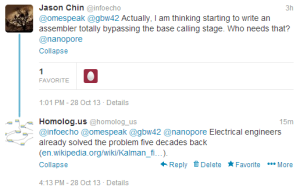
Kalman Filter - a Way to Reconstruct Signal from Noisy Data (as in Nanopore)
By now, we know quite a bit about Oxford Nanopore’s experimental system from their publicly filed patent applications. The sequencer is composed of DNA molecule passing through a small pore, and the patents suggest a few possibilities for that pore-containing molecule. When the DNA passes through the pore, it produces some kind of noisy electrical signal. The challenge is in removing the noise and coming up with the actual signal. We have not seen any bioinformatics patent suggesting that the company did not come up with an elegant way to remove noise.
PacBio has shown that if someone has multiple noisy copies of long DNA sequence, it is possible to reconstruct the correct sequence at 99.99% accuracy. Some kind of Hidden Markov Model (HMM) or Bayesian algorithm is needed to do that. However, that at least requires a base-calling step, but is it possible to start from the noisy electrical sequence, skip the base calling step and go straight to error correction?

A large part of research on HMM were done by electrical engineers in 1950s and 1960s, when they tried to reconstruct communication signal passing through noisy channel. Sean Eddy made a career in bioinformatics by blissfully appropriating that research. We use the description ‘appropriation’, because he not only did not cite Viterbi in his book, but rather went to the extent of copyrighting the ‘HHMer’ name to stop electrical engineers from writing a hardware-accelerated version. Petty complaints aside, what else did the electrical engineers produce that bioinformaticians can appropriate?
As it appears, Kalman filter has not been used extensively in bioinformatics, and definitely not in topics related to reconstructing nucleotide signals. Kalman filter and extended Kalman filter became useful, because HMM was relative slow. Nanopore signal can be used as a time series to use these techniques, but we do not know what kind of difficulties will be posed by the variable speed of data arrival (i.e. DNA molecule passing through the pore at different speed).
The Kalman filter, also known as linear quadratic estimation (LQE), is an algorithm that uses a series of measurements observed over time, containing noise (random variations) and other inaccuracies, and produces estimates of unknown variables that tend to be more precise than those based on a single measurement alone. More formally, the Kalman filter operates recursively on streams of noisy input data to produce a statistically optimal estimate of the underlying system state. The filter is named for Rudolf (Rudy) E. Klmn, one of the primary developers of its theory.
The Kalman filter has numerous applications in technology. A common application is for guidance, navigation and control of vehicles, particularly aircraft and spacecraft. Furthermore, the Kalman filter is a widely applied concept in time series analysis used in fields such as signal processing and econometrics.
The algorithm works in a two-step process. In the prediction step, the Kalman filter produces estimates of the current state variables, along with their uncertainties. Once the outcome of the next measurement (necessarily corrupted with some amount of error, including random noise) is observed, these estimates are updated using a weighted average, with more weight being given to estimates with higher certainty. Because of the algorithm’s recursive nature, it can run in real time using only the present input measurements and the previously calculated state; no additional past information is required.
From a theoretical standpoint, the main assumption of the Kalman filter is that the underlying system is a linear dynamical system and that all error terms and measurements have a Gaussian distribution (often a multivariate Gaussian distribution).
Extensions and generalizations to the method have also been developed, such as the extended Kalman filter and the unscented Kalman filter which work on nonlinear systems. The underlying model is a Bayesian model similar to a hidden Markov model but where the state space of the latent variables is continuous and where all latent and observed variables have Gaussian distributions.